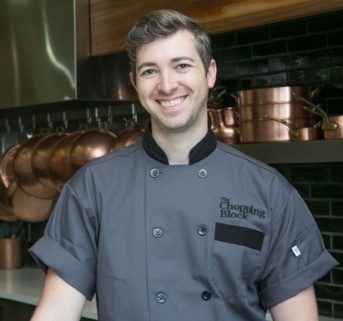I want to state right at the top that this post is going to have graphic images and descriptions of whole animal (deer) butchery. From right after slaughter in the field all the way through hanging, skinning, and meat cutting. It’s not so different from butchery blogs I’ve written in the past, but definitely a bit intense compared to a typical post. If this is the sort of thing you wish to avoid, then consider skipping this one.
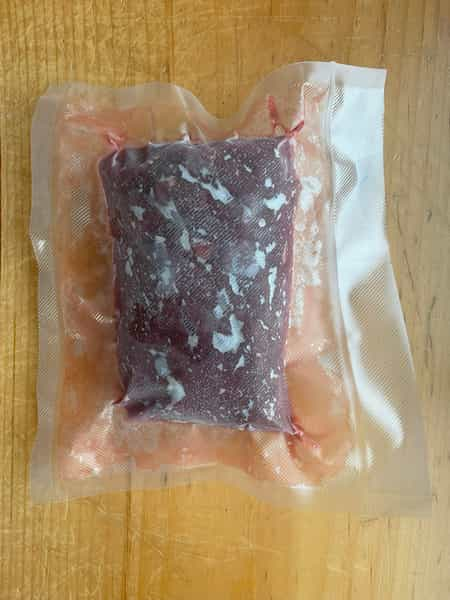 With all that out of the way, however, I do think its fair to say that this is one of the more rewarding projects I’ve been a part of in the last couple years. In the U.S., wild game accounts for a tiny fraction of the average person’s diet compared to just about everywhere else in the world. Hunting is a tradition that most folks in this country have, in large part, abandoned. Certainly there is still a thriving hunting community in many rural areas, but even accounting for this, I don’t think its an exaggeration to say that the typical American will never eat something they—or a member of their community—has dispatched personally (aside from maybe lobster, or other typically sold-live seafood).
With all that out of the way, however, I do think its fair to say that this is one of the more rewarding projects I’ve been a part of in the last couple years. In the U.S., wild game accounts for a tiny fraction of the average person’s diet compared to just about everywhere else in the world. Hunting is a tradition that most folks in this country have, in large part, abandoned. Certainly there is still a thriving hunting community in many rural areas, but even accounting for this, I don’t think its an exaggeration to say that the typical American will never eat something they—or a member of their community—has dispatched personally (aside from maybe lobster, or other typically sold-live seafood).
Even growing up in a rural setting with a fairly strong hunting tradition, I personally was not exposed to it at all as a kid. Aside from the sartorial choices of many of my schoolmates that is (you might be surprised how many different articles of children’s clothing come in blaze orange and camo).
Verily, I had zero interest in hunting growing up, and it wasn’t until I got into cooking in my early 20’s that different types of meat and where they came from started to gain importance to me. I had never even really tasted venison until I was maybe 19 or 20 years old. And while that is pretty late in the game for many kids where I grew up, I daresay a whole lot more people never taste it in their lives. Which is a shame, because not only is wild venison an extremely ecologically sound red meat choice, but it also happens to be incredibly delicious.
In the interest of full disclosure, I don’t actually hunt myself. I have a friend who loves hunting, but doesn’t have the skills or inclination to break down the animals he lands. I do, and I don’t mind being compensated in a portion of the hunt. There is a contingent of people who like to say things like “you shouldn’t eat meat if you aren’t willing to kill the animal yourself.” While I can appreciate that this is probably based in some well-intentioned notion of respecting the life of the animal that feeds you, I do wholly reject such ultimatums. Human society—when its functioning well—is about cooperation, specialization, and reciprocity. Some people are well suited for hunting, others not so much, and that’s okay. But pointing out how this also stems from the same malignant individualism and obsession with self-reliance that poisons much of modern American culture is… another post.
Anyway, early in the morning I was alerted by my friend that a buck had been nabbed.
“No six pointer. Unfortunately.” His text read.
“Damn. Next time.” I replied, encouragingly.
“Cause I got a ******* 8 pointer *************.”
Wow. A fake-out. It was all really quite thrilling.
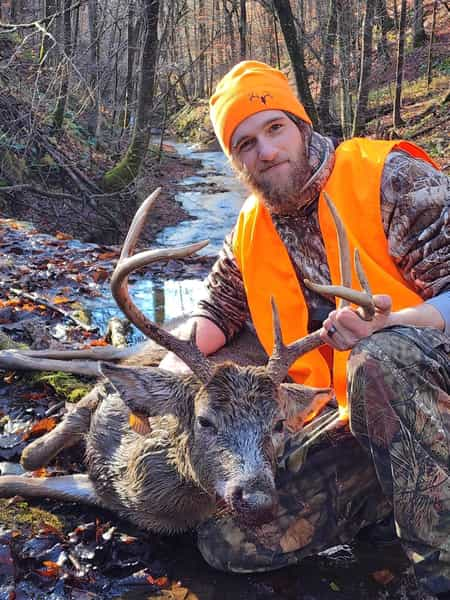 After a kill is confirmed, there are a few things that need to happen before its ready to be broken down into specific cuts. First it needs to be field dressed, which entails removing the organs and ideally cooling the abdominal cavity, typically with ice. The idea here is to cool down the meat as quickly as possible to prevent spoilage. Sometimes certain organs are retained for use as offal, but these are also chilled quickly. After the deer has been recovered from the field it should be hung with its head facing down allow any remaining blood to drain. Ideally shortly thereafter, it should be skinned or ‘caped’. The head is also typically removed along with the hide if the hunter’s intention is to mount it. I was not really privy to any of this. The next time I saw the deer it looked thus:
After a kill is confirmed, there are a few things that need to happen before its ready to be broken down into specific cuts. First it needs to be field dressed, which entails removing the organs and ideally cooling the abdominal cavity, typically with ice. The idea here is to cool down the meat as quickly as possible to prevent spoilage. Sometimes certain organs are retained for use as offal, but these are also chilled quickly. After the deer has been recovered from the field it should be hung with its head facing down allow any remaining blood to drain. Ideally shortly thereafter, it should be skinned or ‘caped’. The head is also typically removed along with the hide if the hunter’s intention is to mount it. I was not really privy to any of this. The next time I saw the deer it looked thus:
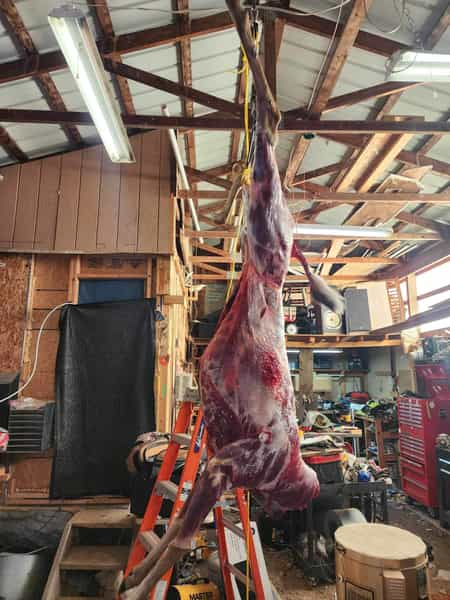 It hangs like this for a few days, maybe a week. This is to make sure its fully out of rigor mortis, and to let the meat relax. This is where I come in. The common breakdown process for deer is interesting in that it is done whole. Typically with larger animals like pigs or cows the carcass is at least split lengthwise and dealt with in two halves. The same could be done for deer, but most often you will see people cutting deer unspilt.
It hangs like this for a few days, maybe a week. This is to make sure its fully out of rigor mortis, and to let the meat relax. This is where I come in. The common breakdown process for deer is interesting in that it is done whole. Typically with larger animals like pigs or cows the carcass is at least split lengthwise and dealt with in two halves. The same could be done for deer, but most often you will see people cutting deer unspilt.
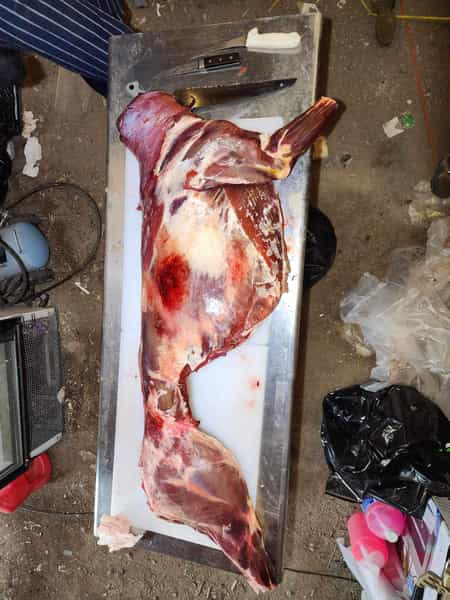 For this reason certain tasks, especially removing the backstrap (the long tender muscle that would be called the loin on a pig, or where ribeye and New York strip come from on a cow), almost feel more akin to filleting a fish than breaking down a 200 pound animal.
For this reason certain tasks, especially removing the backstrap (the long tender muscle that would be called the loin on a pig, or where ribeye and New York strip come from on a cow), almost feel more akin to filleting a fish than breaking down a 200 pound animal.
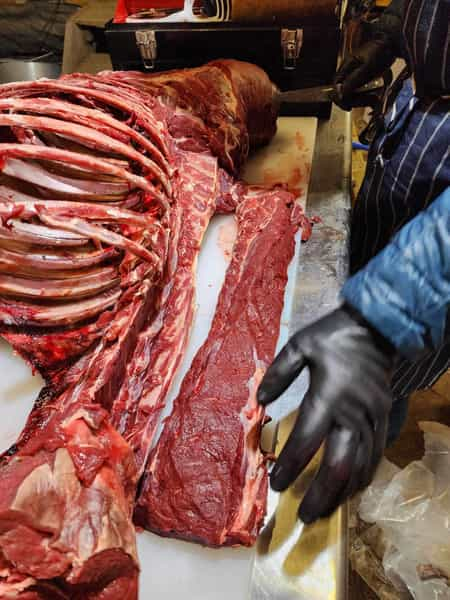 As I worked on cutting and trimming the different cuts, my friend got started vacuum sealing and freezing all the finished bits. Of course the goal here is for none of it to go to waste. I tried as best I could to prise every bit of meat from the skeleton, but inevitably some small amount is left behind. I’m also a bit rusty; my next deer will be better.
As I worked on cutting and trimming the different cuts, my friend got started vacuum sealing and freezing all the finished bits. Of course the goal here is for none of it to go to waste. I tried as best I could to prise every bit of meat from the skeleton, but inevitably some small amount is left behind. I’m also a bit rusty; my next deer will be better.
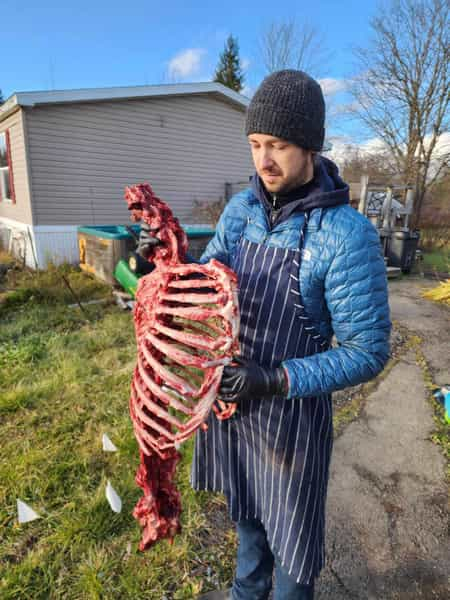 For this reason, it's always worthwhile to try to make stock from as much of the remainder as possible. While I wouldn’t necessarily consider it waste per se to return some portion of the animal to the ecosystem, Its always better to take direct responsibility for as much of the carcass as you can, because while for the moment white tailed deer are so abundant as to be considered pests in my area, history has shown us countless times how the hubris of over-extraction will eventually render the landscape denuded and barren. Best to always simply take what you need, and make use of it all, no matter how inexhaustible your supply may seem (deliberate over-population control (especially of invasive species) notwithstanding).
For this reason, it's always worthwhile to try to make stock from as much of the remainder as possible. While I wouldn’t necessarily consider it waste per se to return some portion of the animal to the ecosystem, Its always better to take direct responsibility for as much of the carcass as you can, because while for the moment white tailed deer are so abundant as to be considered pests in my area, history has shown us countless times how the hubris of over-extraction will eventually render the landscape denuded and barren. Best to always simply take what you need, and make use of it all, no matter how inexhaustible your supply may seem (deliberate over-population control (especially of invasive species) notwithstanding).
I hope this will become a late autumn tradition for me. It connects me to the land and season in such a direct and tactile way. Something a bit more meaningful for which to give thanks than a plastic wrapped, water-plumped turkey from the grocery store. If you too would like some novel additions to your fall food traditions, but aren’t quite ready to don the camo and buck knife, why not check out our upcoming Fall Dinner Party class (the beef tenderloin with red wine sauce would work equally well as a venison recipe, just sayin’).


